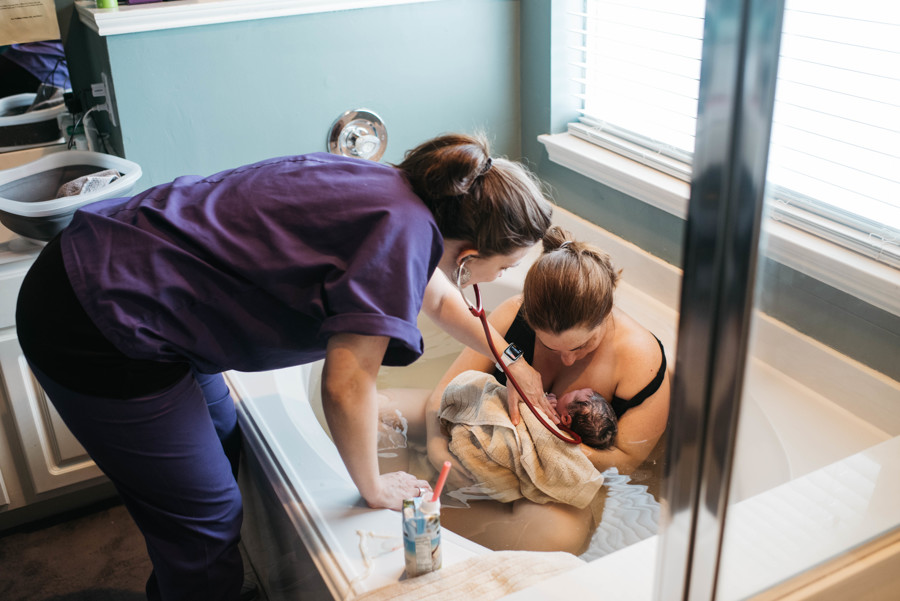Out of hospital birth has been embraced by many natural mamas and is increasing in popularity… again!
Out of hospital birth was the norm until the early part of the 20th century when women started going to the hospital (and sometimes not making it there!) to give birth. So out of hospital birth is the traditional way of birthing a baby but, is it safe?
Birth Center and Home Birth is a safe choice for most women
Studies are piling up that show out of hospital birth is very safe for low risk women. In fact, British regulators are urging women to consider out of hospital birth because home and birth center birth can be safer than a hospital birth for many women. But how?
Midwifery care lowers the risk for interventions

Midwifery care has been shown to lower the risk of medical interventions for low risk women. One reason may be that fear of childbirth slows labor (more about this later). Being in a home-like environment without beeps and wires, can help mom to relax and feel safe. Another reason is that individualized care is simply better. Midwifery care is evidence based care which is very different from the standard care of US hospitals. Evidence based care doesn’t routinely rupture membranes, induce without clear cause, or inhibit mom from moving or eating and drinking. None of these interventions are evidence based yet hospitals routinely perform them. And finally, hospitals have protocol and policies. It’s difficult for staff to give individual care when they have to adhere to these guidelines. Hospitals are businesses that need to function profitably. Birth is sometimes slow and always unpredictable. Keeping labor on a timeline helps keep things moving along. While midwifery care for home birth or birth center birth do have policies, procedures, and state laws to adhere to, it is individualized and encourages labor to begin on it’s own and progress on it’s own, at it’s own rate as long as mother and baby remain healthy and well.
MIDWIVES ARE TRAINED PROFESSIONALS

Out of hospital birth doesn’t mean there is no help available if something unexpectedly goes wrong. There are many studies that show that perinatal outcomes for low risk women in a birth center or planned home birth are as good or better than those from planned hospital births. Women who plan a home birth or birth center birth know that if a complication arises that would make a hospital birth safer (preeclampsia, preterm birth, etc.) their midwife will tell them and make the arrangements. Midwives are trained to notice complications at each prenatal appointment so that they can discuss transferring care or consulting specialists early if needed. During labor they will also keep monitoring mom and baby to be sure labor is progressing normally. Midwives are trained to notice complications before they become emergent. In fact, most transfers are not emergencies which means you and your partner can have time to discuss options and make peace with your decision. Midwives are also prepared with oxygen, medications to stop bleeding, supplies to start an IV, and resuscitation skills and equipment if needed. Midwives have the clinical training to manage hosts of complications on-site to such as hemorrhage, shoulder dystocia, neonatal resuscitation, etc., and will not hesitate to facilitate transfer of care if needed. In fact, midwives carry with them almost all of the emergency supplies that a hospital has, excluding a cesarean section.
“I’VE HEARD THAT HOME OR BIRTH CENTER BIRTH IS UNSAFE AND RECKLESS. WHAT GIVES?”
Some believe that out of hospital birth is a medieval healthcare option. Others think home and birth center birth is selfish because moms just want to be comfortable without regard for their baby’s health. All of these assumptions are wrong and disproven by science.
BIRTH IS A NORMAL BIOLOGICAL FUNCTION
The problem is that the people who believe that home birth is reckless think about birth as a medical condition. That means that they compare childbirth to open heart surgery or an appendix removal, both of which would be safest to do at a hospital (and unsafe anywhere else). The truth is childbirth is a normal biological function that usually happens just fine on it’s own. Of course serious complications can arise, which is why birth should be attended by trained professional.
STUDIES ARE BIASED
Many studies that show adverse affects from out of hospital birth are not quality studies. For example, one group of physicians urged doctors to discourage home birth and suggested that anyone who supported home birth should be “subject to peer review and justifiably incur professional liability and sanction from state medical boards”. These practitioners opened their argument with research that included unplanned home births which has been greatly criticized. Wendy Gordon LM, CPM, MPH, writes:
“The authors cited several more poor-quality studies, as well as 52 citations of commentaries, opinions and anecdotes (some even pulled from the popular media) to build their “evidence” basis. They conveniently ignored the large and growing body of literature that continues to show that planned home birth with qualified and experienced midwives holds no greater risk of perinatal mortality than birth in the hospital, and in fact results in far fewer interventions and lower risk of maternal and perinatal morbidity.”
We know that home births that are not attended by a qualified midwife or other healthcare provider have significantly more risks than those that are planned in advance and involve certified nurse midwives, certified professional midwives, or physicians. An important study shows that home birth for low risk women reduces the rate of interventions without increasing adverse outcomes. The reason this study is so important is that it’s the first one to account for planned place of birth instead of just actual place of birth. That means that it included women who gave birth in the hospital but had planned a home birth, showing that yes, women can plan a home birth and transfer to hospital if needed without any adverse affects to mom or baby. This study just adds to the growing pool of information that shows home birth is safe.
HOSPITAL BIRTH CARRIES ADDED RISKS
Some may argue that the hospital is the best place to give birth because you are near help if it’s needed. This theory could be correct if hospital birth didn’t come with it’s own set of serious risks.
INFECTION
Hospital associated infections (HAIs) are a well known cause of morbidity and mortality in the United States. The CDC states that at least 1 in 25 patients acquires a hospital associated infection. Out of hospital births have fewer neonatal infections because they not have the resistant superbugs that a (sterile) hospital does.

FEAR AND THE CASCADE OF INTERVENTIONS
Hospitals are not home like. For a lot of women, even if they believe, intellectually, that the hospital is the safest place to birth, their primal subconscious (the part that gives birth) is hindered by the unfamiliar. When a laboring mom is fearful she releases adrenaline which interferes with oxytocin and stops or slows labor. In nature this is a good thing. If there is a danger nearby mom needs to get somewhere safer for birth. However, in the hospital this means her labor has “stalled” and she will probably be given pitocin to get it going again. The use of pitocin can increase the pain mom feels since pitocin doesn’t cross the blood brain barrier like oxytocin does. This means that endorphins aren’t released for natural pain relief. From here it’s much more likely that mom will need pain meds, assisted delivery or c-section. Low risk women who choose to birth in a hospital are much more likely to have third and fourth degree tears, hemorrhage and c-section than low risk women who choose out of hospital birth. The U.S. C-section rate for low risk women planning a hospital birth lingers around 30% while women who have planned a home or birth center birth have a much lower risk, about 5%.
DANGERS OF EARLY CORD CLAMPING AND INFANT SEPARATION
Early cord clamping was found to lower a newborns blood volume by as much as 40%. Losing that much blood doesn’t happen at any other time of life without severe consequences, including death. This blood volume reduction increases the need for blood transfusions. You can ask for your doctors not to clamp or cut the cord until the placenta stops pulsating, but keep in mind that they may do it anyway if even the slightest complication arises (like meconium in the water), even though this isn’t evidence based practice. If there is meconium in the water or another reason that baby needs attention you will often be separated. Even a short amount of separation can interfere with bonding and breastfeeding. A separation in the first hour of life means that baby is not stimulating mom to release oxytocin which helps contract the uterus and avoid postpartum hemorrhage.
IS OUT OF HOSPITAL BIRTH RIGHT FOR YOU?
Here are some guidelines. Of course, talk with your healthcare provider to make the best decision for you and your family.
OUT OF HOSPITAL BIRTH MAY BE A GREAT OPTION FOR YOU IF…
- You are low risk
- You want individualized and evidence based midwifery care
- You want to avoid unnecessary interventions
- You trust the evidence that proves it’s safe
OUT OF HOSPITAL BIRTH MAY NOT BE A GOOD FIT IF…
- You don’t believe it’s safe
- You are carrying multiples
- You have uncontrolled diabetes
- You have preeclampsia or high blood pressure
- You go into labor early (before 37 weeks)
The above information and evidence and study citations are found at Mama Natural.
